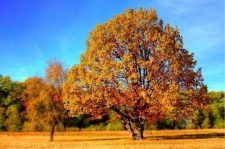We have had numerous reports on tall fescue lawns that greened up this spring but have developed or are developing brown spots. In some cases this leaves the lawn with a pockmarked appearance or larger areas may be browned due to individual spots coalescing. We have found sod webworm damage on turf areas in the Frankfort, KS area (Marshall County) but individual turfgrass areas should be checked to confirm sod webworm as there can be other causes of turf problems. For example, we have also had reports of bronze cutworm damage or a warm-season grass greening up later than tall fescue.
If is very rare for sod webworm damage to show up at this time of year. I have only seen this once before in over 25 years of editing this newsletter.
Look for individual grass blades cut off at ground level. You may also find silken tunnels that the insects use to hide during the day. Large numbers of birds pecking holes in the lawn can also alert you to their presence. Most feeding takes place at night but they may feed during the day on overcast days. They can be especially active near dusk. Individual larva have a brown head capsule and spots down the side. See photo included in the web and blog versions of this newsletter.
Control measures should be considered when you find 2 to 4 webworms per square foot of sod. Irrigate (½ to ¾ inch) to bring the webworms close to the surface unless you can find them feeding. Treat in late afternoon or early evening when the insects are most active. Apply another 1/8 inch of water if possible to activate the insecticide. Suggested insecticides include bifenthrin (Talstar, Bug B Gon Max Insect Killer for Lawns, Ortho Insect Killer for Lawns Granules, Bug Blaster II) and cyhalothrin (Scimitar, Spectracide Triazicide). For more information, see https://hnr.k-state.edu/extension/horticulture-resource-center/common-pest-problems/documents/Sod%20Webworm.pdf . Many thanks to Jason Rugan of Rugan Lawn & Landscape for helping us ID this problem. Let me emphasize again that there can be other causes of turf decline so don’t assume you have sod webworm without checking for their presence.
Ward Upham, Extension Agent




